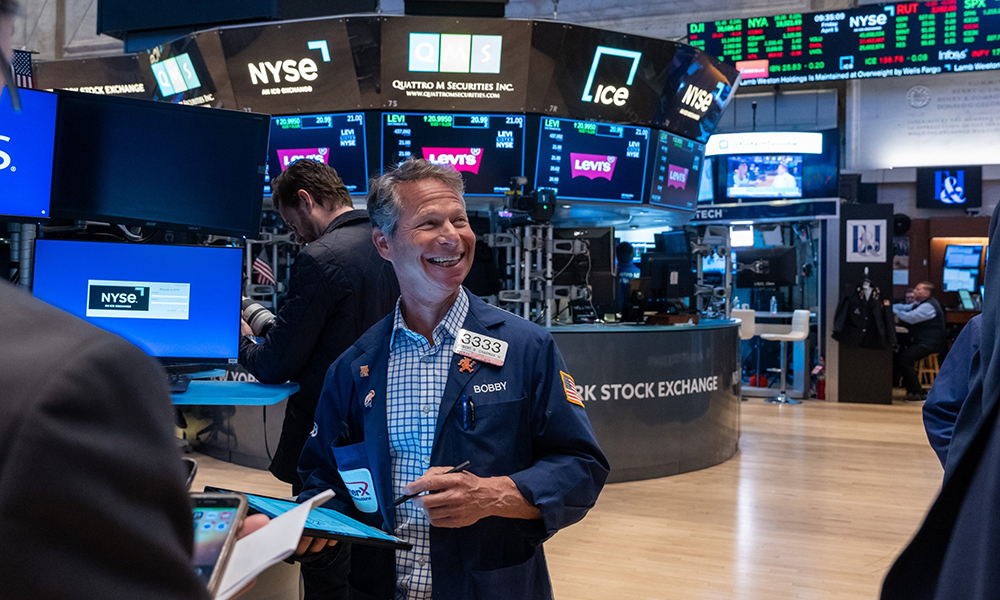
無論是在美國本土還是海外,,投資者對人工智能的熱情推動科技股今年創(chuàng)下新高。追蹤數(shù)十個發(fā)達和發(fā)展中市場大中型科技股的iShares MSCI AC全球信息技術(shù)指數(shù)(iShares MSCI AC World Information Technology Index)過去12個月飆升逾20%,。而在美國國內(nèi),,備受追捧的追蹤美國大盤科技股的景順QQQ信托系列1交易所交易基金同期上漲了近40%。
這一系列的良好表現(xiàn)是如此引人注目,,以至于上周即使是一個小挫折,,也引起了華爾街的熱議。美國科技股和半導(dǎo)體股分別下跌了1%和2.1%,,瑞銀全球財富管理公司(UBS Global Wealth Management)美洲區(qū)首席投資官索利塔·馬切利(Solita Marcelli)提醒投資者,,市場修正是正常現(xiàn)象,,“人工智能驅(qū)動的科技股漲勢并非單行道”,。
這位資深市場觀察人士指出,地緣政治緊張局勢升溫,,以及勞動力市場數(shù)據(jù)強于預(yù)期后美國降息預(yù)期的改變,,令科技股承壓,。不過,馬切利表示,,科技股近期表現(xiàn)不佳并未改變她對人工智能相關(guān)股的樂觀看法,。
她在周一的一份報告中寫道:“由于人工智能的基本面強勁,我們預(yù)計2024年全球科技公司的盈利將同比增長18%,,而且未來12個月的遠期市盈率約為27倍,,因此我們繼續(xù)看好全球科技公司,尤其是人工智能價值鏈上的公司,?!?/p>
需求和產(chǎn)品增加,而且有證據(jù)表明人工智能的應(yīng)用正在增加
馬切利給出了她看好人工智能股票的三大主要原因:“突破性”人工智能產(chǎn)品即將推出,;有證據(jù)表明人工智能的應(yīng)用正在增加;需求趨勢正在擴大,。
自O(shè)penAI于2022年11月向全球發(fā)布聊天機器人ChatGPT以來,,科技行業(yè)一直在競相發(fā)布新人工智能產(chǎn)品。生成式人工智能使文本轉(zhuǎn)視頻平臺(如OpenAI的Sora)和文本轉(zhuǎn)音樂平臺(如Stability AI的Audio 2.0)的興起成為可能,,但人工智能也被用于醫(yī)療保健領(lǐng)域,,以尋找改變世界并可能帶來豐厚利潤的新藥,它還會帶來許多新軟件工程應(yīng)用程序,。馬切利說,,創(chuàng)新的步伐如此之快,她預(yù)計“未來數(shù)個季度還會造就更多這樣的突破性創(chuàng)新”,。
新人工智能產(chǎn)品的潛力有助于擴大對該技術(shù)的需求,。馬切利表示,在去年主要由大型科技公司客戶引領(lǐng)發(fā)展之后,,如今“人工智能需求日益普及的跡象更加明顯”,。她強調(diào),瑞典,、新加坡,、日本、韓國等主權(quán)國家是增量需求的主要來源,。
管理著1940億美元資產(chǎn)的投資管理公司杰尼桑合伙公司(Jennison Associates)的科技股投資組合經(jīng)理埃里卡·克勞爾也持類似觀點,。她此前曾向《財富》雜志解釋說,世界各國政府基本上都想擁有“自己版本的ChatGPT,,利用自己的語言,、文獻進行訓(xùn)練,從而保留文化細微差別”,,這意味著人工智能公司可以利用大量新支出,。
埃里卡的觀點相當(dāng)中肯,,甲骨文公司(Oracle)董事長兼首席技術(shù)官、億萬富翁拉里·埃里森透露,,他的公司正與數(shù)個國家和主權(quán)地區(qū)就在云上運行政府應(yīng)用程序進行談判,,包括人工智能。埃里森在最近的財報電話會議上表示:“幾乎每國政府都想擁有自己的主權(quán)云,?!?/p>
至于人工智能應(yīng)用的證據(jù),瑞銀的馬切利指出,,最近的調(diào)查顯示,,使用人工智能的公司比例不斷上升。根據(jù)美國人口普查局(U.S. Census Bureau)的《商業(yè)趨勢與展望調(diào)查》(Business Trends and Outlook Survey),,雖然截至第一季度,,只有5.4%的美國公司在使用人工智能,但這一比例仍遠高于2023年第三季度的3.7%,。馬切利預(yù)測,,未來6個月,這一比例可能會升至6.6%至12%,。
她還指出,,科技行業(yè)的人工智能采用率要高得多。例如,,在人口普查局的信息部門(北美產(chǎn)業(yè)分類體系51)中,,18%的公司表示它們在第一季度使用人工智能來生產(chǎn)商品或服務(wù)。馬切利總結(jié)道:“我們?nèi)匀豢春酶鼜V泛的人工智能主題,?!?/p>
最大的威脅:美聯(lián)儲保持鷹派立場
雖然人工智能相關(guān)公司仍有一些利好因素,但巨大的威脅即將到來,。就在數(shù)個月前,,投資者還確信美聯(lián)儲將在今年夏天降息??赡艹霈F(xiàn)的借貸成本下降使得股市今年表現(xiàn)優(yōu)于預(yù)期,,但近期多份熱度高于預(yù)期的通脹報告和一些意外強勁勞動力市場數(shù)據(jù),讓專家們擔(dān)心美聯(lián)儲近期不會降息,。正如Treasury Partners首席投資官理查德·薩普斯登告訴《財富》雜志的那樣:“由于失業(yè)率低,、經(jīng)濟強勁、通脹率高于美聯(lián)儲2%的目標(biāo),,我們不太可能在7月之前看到任何降息,。”
如果情況果真如此,,科技股可能會遭遇回調(diào),??萍脊杀灰暈楦唢L(fēng)險資產(chǎn),因此在利率上升時通常會面臨壓力,。薩普斯登警告稱,,“隨著股票估值接近歷史高點,推動股價進一步上漲的重?fù)?dān)就落在了盈利上”,。
他補充說:“鑒于市盈率和債券收益率上升,,在財報季提供明確的盈利增長證據(jù)之前,我們對股市仍持謹(jǐn)慎態(tài)度,?!保ㄘ敻恢形木W(wǎng))
譯者:中慧言-王芳
無論是在美國本土還是海外,投資者對人工智能的熱情推動科技股今年創(chuàng)下新高,。追蹤數(shù)十個發(fā)達和發(fā)展中市場大中型科技股的iShares MSCI AC全球信息技術(shù)指數(shù)(iShares MSCI AC World Information Technology Index)過去12個月飆升逾20%,。而在美國國內(nèi),備受追捧的追蹤美國大盤科技股的景順QQQ信托系列1交易所交易基金同期上漲了近40%,。
這一系列的良好表現(xiàn)是如此引人注目,,以至于上周即使是一個小挫折,也引起了華爾街的熱議,。美國科技股和半導(dǎo)體股分別下跌了1%和2.1%,瑞銀全球財富管理公司(UBS Global Wealth Management)美洲區(qū)首席投資官索利塔·馬切利(Solita Marcelli)提醒投資者,,市場修正是正?,F(xiàn)象,“人工智能驅(qū)動的科技股漲勢并非單行道”,。
這位資深市場觀察人士指出,,地緣政治緊張局勢升溫,以及勞動力市場數(shù)據(jù)強于預(yù)期后美國降息預(yù)期的改變,,令科技股承壓,。不過,馬切利表示,,科技股近期表現(xiàn)不佳并未改變她對人工智能相關(guān)股的樂觀看法,。
她在周一的一份報告中寫道:“由于人工智能的基本面強勁,我們預(yù)計2024年全球科技公司的盈利將同比增長18%,,而且未來12個月的遠期市盈率約為27倍,,因此我們繼續(xù)看好全球科技公司,尤其是人工智能價值鏈上的公司,?!?/p>
需求和產(chǎn)品增加,而且有證據(jù)表明人工智能的應(yīng)用正在增加
馬切利給出了她看好人工智能股票的三大主要原因:“突破性”人工智能產(chǎn)品即將推出,;有證據(jù)表明人工智能的應(yīng)用正在增加,;需求趨勢正在擴大,。
自O(shè)penAI于2022年11月向全球發(fā)布聊天機器人ChatGPT以來,科技行業(yè)一直在競相發(fā)布新人工智能產(chǎn)品,。生成式人工智能使文本轉(zhuǎn)視頻平臺(如OpenAI的Sora)和文本轉(zhuǎn)音樂平臺(如Stability AI的Audio 2.0)的興起成為可能,,但人工智能也被用于醫(yī)療保健領(lǐng)域,以尋找改變世界并可能帶來豐厚利潤的新藥,,它還會帶來許多新軟件工程應(yīng)用程序,。馬切利說,創(chuàng)新的步伐如此之快,,她預(yù)計“未來數(shù)個季度還會造就更多這樣的突破性創(chuàng)新”,。
新人工智能產(chǎn)品的潛力有助于擴大對該技術(shù)的需求。馬切利表示,,在去年主要由大型科技公司客戶引領(lǐng)發(fā)展之后,,如今“人工智能需求日益普及的跡象更加明顯”。她強調(diào),,瑞典,、新加坡、日本,、韓國等主權(quán)國家是增量需求的主要來源,。
管理著1940億美元資產(chǎn)的投資管理公司杰尼桑合伙公司(Jennison Associates)的科技股投資組合經(jīng)理埃里卡·克勞爾也持類似觀點。她此前曾向《財富》雜志解釋說,,世界各國政府基本上都想擁有“自己版本的ChatGPT,,利用自己的語言、文獻進行訓(xùn)練,,從而保留文化細微差別”,,這意味著人工智能公司可以利用大量新支出。
埃里卡的觀點相當(dāng)中肯,,甲骨文公司(Oracle)董事長兼首席技術(shù)官,、億萬富翁拉里·埃里森透露,他的公司正與數(shù)個國家和主權(quán)地區(qū)就在云上運行政府應(yīng)用程序進行談判,,包括人工智能,。埃里森在最近的財報電話會議上表示:“幾乎每國政府都想擁有自己的主權(quán)云?!?/p>
至于人工智能應(yīng)用的證據(jù),,瑞銀的馬切利指出,最近的調(diào)查顯示,,使用人工智能的公司比例不斷上升,。根據(jù)美國人口普查局(U.S. Census Bureau)的《商業(yè)趨勢與展望調(diào)查》(Business Trends and Outlook Survey),雖然截至第一季度,只有5.4%的美國公司在使用人工智能,,但這一比例仍遠高于2023年第三季度的3.7%,。馬切利預(yù)測,未來6個月,,這一比例可能會升至6.6%至12%,。
她還指出,科技行業(yè)的人工智能采用率要高得多,。例如,,在人口普查局的信息部門(北美產(chǎn)業(yè)分類體系51)中,18%的公司表示它們在第一季度使用人工智能來生產(chǎn)商品或服務(wù),。馬切利總結(jié)道:“我們?nèi)匀豢春酶鼜V泛的人工智能主題,。”
最大的威脅:美聯(lián)儲保持鷹派立場
雖然人工智能相關(guān)公司仍有一些利好因素,,但巨大的威脅即將到來,。就在數(shù)個月前,投資者還確信美聯(lián)儲將在今年夏天降息,??赡艹霈F(xiàn)的借貸成本下降使得股市今年表現(xiàn)優(yōu)于預(yù)期,但近期多份熱度高于預(yù)期的通脹報告和一些意外強勁勞動力市場數(shù)據(jù),,讓專家們擔(dān)心美聯(lián)儲近期不會降息,。正如Treasury Partners首席投資官理查德·薩普斯登告訴《財富》雜志的那樣:“由于失業(yè)率低、經(jīng)濟強勁,、通脹率高于美聯(lián)儲2%的目標(biāo),,我們不太可能在7月之前看到任何降息?!?/p>
如果情況果真如此,,科技股可能會遭遇回調(diào),??萍脊杀灰暈楦唢L(fēng)險資產(chǎn),因此在利率上升時通常會面臨壓力,。薩普斯登警告稱,,“隨著股票估值接近歷史高點,推動股價進一步上漲的重?fù)?dān)就落在了盈利上”,。
他補充說:“鑒于市盈率和債券收益率上升,,在財報季提供明確的盈利增長證據(jù)之前,我們對股市仍持謹(jǐn)慎態(tài)度,?!保ㄘ敻恢形木W(wǎng))
譯者:中慧言-王芳
Investors’ AI enthusiasm has helped lift technology stocks to new heights this year, both in the U.S. and abroad. The iShares MSCI AC World Information Technology Index, which tracks large- and midcap tech stocks in dozens of developed and developing markets, has surged more than 20% over the past 12 months. And domestically, the vaunted Invesco QQQ Trust Series 1 ETF, which tracks large-cap U.S. tech stocks, is up nearly 40% over the same period.
The run of good form has been so dramatic that even a minor speed bump last week has Wall Street talking. A mere 1% decline in U.S. tech stocks and a 2.1% decline in semiconductor shares led Solita Marcelli, chief investment officer Americas at UBS Global Wealth Management, to remind investors that corrections are natural—“the AI-driven tech rally is not a one-way street.”
The veteran market watcher noted that rising geopolitical tensions and changing forecasts for U.S. interest rate cuts after stronger than expected labor-market data were weighing on tech shares. Still, Marcelli said tech’s very recent underperformance hasn’t changed her positive view of AI-related stocks.
“With robust AI fundamentals, our expectations of 18% year-over-year earnings growth for global tech in 2024, and a reasonable 12-month forward price-to-earnings ratio of around 27x, we stay positive on global tech and companies in the AI value chain in particular,” she wrote in a Monday note.
More demand, more products, and evidence of increasing adoption
Marcelli gave three key reasons for her optimism on AI stocks: the imminent launch of “revolutionary” AI products; evidence of increasing AI adoption; and broadening demand trends.
Ever since OpenAI released its chatbot ChatGPT to the world in November 2022, there’s been a race to release new AI products in the tech sector. Generative AI has enabled the rise of text-to-video platforms like OpenAI’s Sora and text-to-music platforms like Stability AI’s Audio 2.0, but AI is also being used in health care to look for world-changing and potentially lucrative new drugs, and it has numerous new software engineering applications. Marcelli said that the pace of innovation is so strong that she expects “more such breakthrough innovations in the next few quarters” as well.
The potential for new AI products is likely to help broaden demand for the technology. After mostly being led by Big Tech customers last year, Marcelli said there are now “clearer signs of AI demand becoming more ubiquitous.” She highlighted sovereign entities including Sweden, Singapore, Japan, Korea, and more as key sources of incremental demand.
Erika Klauer, a technology equity portfolio manager at Jennison Associates, an investment management firm with $194 billion in assets under management, shared a similar view. She previously explained to Fortune that governments around the world essentially want “their own version of ChatGPT, with training on their own languages … their own archives, their own cultural nuances,” and that means a lot of new spending for AI companies to take advantage of.
To her point, the billionaire chairman and chief technology officer of Oracle, Larry Ellison, revealed that his company is negotiating with several countries and sovereign regions to run government applications on the cloud, including AI. “Pretty much every government is going to want a sovereign cloud,” Ellison said on a recent earnings call.
As far as evidence of AI adoption, UBS’s Marcelli pointed to recent surveys that show a rising percentage of companies using AI. While only 5.4% of U.S. companies were using AI as of the first quarter, according to the U.S. Census Bureau’s Business Trends and Outlook Survey, that’s still well above the 3.7% figure from the third quarter of 2023. And Marcelli predicted that this share could rise to between 6.6% and 12% over the next six months.
She also noted that AI adoption rates are much higher in the tech sector. In the Census Bureau’s information sector (NAICS 51), for example, 18% of companies said they used AI to produce goods or services in the first quarter. “We remain positive on the broader AI theme,” Marcelli concluded.
The big threat: A hawkish Fed
While AI-related companies still have some tailwinds, there is a big threat on the horizon. Just months ago, investors were certain that the Federal Reserve would be cutting interest rates this summer. The potential for lower borrowing costs helped the stock market outperform this year, but multiple hotter-than-expected inflation reports and some surprisingly strong labor market data recently have led experts to fear that the Fed won’t be cutting rates anytime soon. As Richard Saperstein, chief investment officer at Treasury Partners, told Fortune: “With low unemployment, economic strength, and inflation above the Fed’s 2% target, it’s unlikely we’ll see any rate cuts before July.”
If that turns out to be the case, tech stocks, which are seen as higher-risk assets and thus typically face pressure when rates rise, could suffer a pullback. And Saperstein warned that “with stock valuations near record highs, the burden is on earnings to drive further rises in stock prices.”
“Given the elevated market multiples and rising bond yields, we remain cautious on stocks until earnings season delivers clear evidence of earnings growth,” he added.






